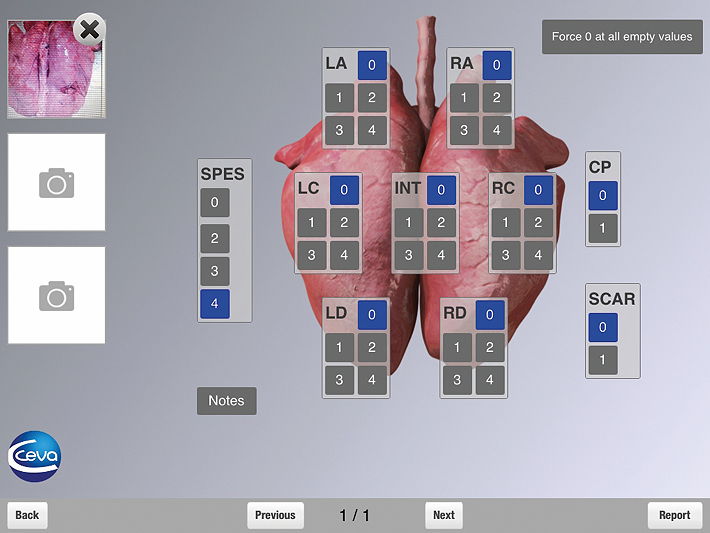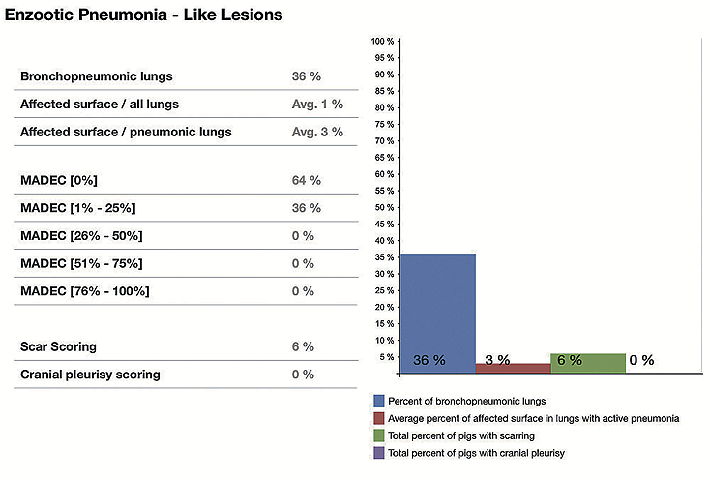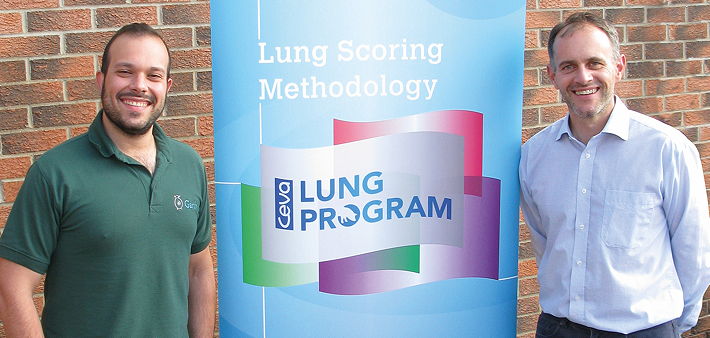Ceva Animal Health launched its new Mycoplasma hyopneumoniae (M hyo) vaccine, Hyogen, into the European market in September as part of the company’s strategy to fight the losses suffered by pig producers due to enzootic pneumonia. But that’s only part of the story; its introduction has been accompanied by the Ceva Lung Program (CLP) that can be used to evaluate respiratory disease in herds before and after vaccine treatment.
The Ceva Lung program offers the methodology and guidelines on how to correctly evaluate the presence, incidence, circulation patterns and impact of M hyo and Actinobacillus pleuropneumoniae (Ap) infections using serological investigation and adapted lung scoring of slaughter pigs. It’s used to determine the appropriate vaccination protocol for herds affected by these conditions, and to monitor the results of vaccination protocols.
Pictured above are vet Eduardo Velazquez (left) and Ceva UK swine manager Paul Penny
The program has been introduced in the UK following the launch of Ceva’s new Hyogen vaccine. This combines two new vaccine components: BA-2940-99, a proprietary M hyo strain, and Imuvant, a unique adjuvant containing non-toxic lipopolysaccharides from J5 Escherichia coli. A single injection from 21 days of age will provide 26 weeks of immunity protection against M hyo.
Another new vaccine, Coglapix, is also now available from Ceva that provides protection against Ap, and together, the two vaccine treatments and the CLP evaluation service make up Ceva’s comprehensive lung health offering to the pig sector.
“What we’re doing is more than just introducing new vaccines,” Ceva UK swine manager Paul Penny says. “We’re also adding lung monitoring support to pig producers in the field. And there’s also a Ceva Respinomics app being developed that will do the calculations to show the financial benefits of adopting a vaccination programme.”
At the centre of CLP is a new app developed by the company for tablet computers for vets to accurately score pig lungs in the abattoir. It allows pneumonia and pleurisy to be evaluated in a qualitative and quantitative manner.
Pneumonia is scored based on the Madec method, which has been modified taking into account the contribution of each lobe to the overall capacity of the lungs. The quantity of scarring is also included.

Pleurisy, meanwhile, is scored using the Slaughterhouse Pleurisy Evaluation System (SPES). This allows the Actinobacillus pleuropneumoniae index (APPI) to be calculated for Ap-induced dorsocaudal pleurisy.
Using the Ceva app, the lungs are evaluated and a score entered for each pig as it progresses along the kill line. Under the modified Madec Scoring, the enzootic pneumonia-like lung lesions of each lobe are quantified as follows:
Score 0 – No lesions;
Score 1 – 1% to 25%;
Score 2 – 26% to 50%;
Score 3 – 51% to 75%;
Score 4 – 76% to 100%.
The prevalence of fissures, or scarring, is also evaluated based on their presence or absence. The incidence of fissures indicates old infections that were likely due to M hyo, and the scores here are:
Score 0 – Absence of fissures or scarring;
Score 1 – Presence of fissures or scarring.
Cranial pleurisy can be attributed to pathological processes that are likely related to M hyo. It’s recorded separately from the dorsocaudal pleurisy to allow for appropriate differential diagnosis. Pleurisy in the apical and cardiac lung lobes is scored as follows:
Score 0 – No pleurisy in apical and cardiac lung lobes;
Score 1 – Pleurisy in apical and cardiac lung lobes.
Dorsocaudal pleurisy is then measured based on SPES, and the app allows the assessment of pleural lesions according to their location, appearance and extension. The SPES method is based on the following point system:
Score 0 – Absence of chronic pleurisy lesions;
Score 2 – Dorsocaudal monolateral focal lesion;
Score 3 – Bilateral lesion of type 2 or extended monolateral lesion;
Score 4 – Severely extended bilateral lesion.
Processing scores
Through statistical processing of the recorded data, the CLP enables not only measurement of the incidence of the injury caused by lung disease, but also identification of the distribution by classes within the sample. It even displays the data in easily legible graphic displays, and is capable of providing information about the frequency, severity and suspected origin of pathological changes most likely due to M hyo and Ap.
The information provided includes: the average percentage of affected surface out of all lungs, which gives the actual value of the lungs that are damaged by enzootic pneumonia on average in the group of evaluated animals; the average percentage of affected surface out of pneumonic lungs, which gives information about the extent of the lesions and thus severity of the infection in the sick animals; and the average percentage of scarring in pneumonic lungs, which indicates old infections likely due to M hyo in the herd.

Cranial pleurisy is scored based on its presence or absence. The percentage of cranial pleurisy in the evaluated group indicates the probability of the previous infection of pathogens affecting the cranial part of the lungs, especially M hyo. And finally the APPI provides information regarding the prevalence and seriousness of any dorsocaudal pleurisy, which is highly indicative of prior pleuropneumonia due to Ap.
Correct diagnosis
The CLP monitoring and scoring methodology is designed to assist in identifying the correct diagnosis of respiratory disease through the evaluation of lungs at slaughter. It enables the discovery of even subclinical infections that weren’t noted during the growing period.
The calculated values allow the estimation of both the incidence and the severity of enzootic pneumonia and pleuropneumonia, and it can also be used to evaluate the efficacy of the control measures against M hyo and Ap when used both prior to and after their implementation.
And when used routinely, it can aid in the recognition of the dynamics of those infections in a defined period or to highlight seasonal differences.
Ceva’s Paul Penny says the CLP provides beneficial in-depth analysis for evaluating vaccine efficacy, particularly SPES that provides additional qualitative information compared to the BPHS pleurisy scoring method.
“It allows veterinary practices that recommend the use of our vaccines to look in detail at the lungs of their customers’ pigs before and after implementing the vaccine protocol to see what’s happening,” he adds. “It’s a value added service we offer to pig producers.”
Eduardo Velazquez of the Garth Pig Practice has already used the Ceva Lung Program app in the abattoir to evaluate lungs and is confident it has a place in managing pig health on UK farms.
“It’s a novel approach to lung scoring, and a useful new diagnostic tool,” he says. “It’s something else we can add to the lung health tools we already have.”




